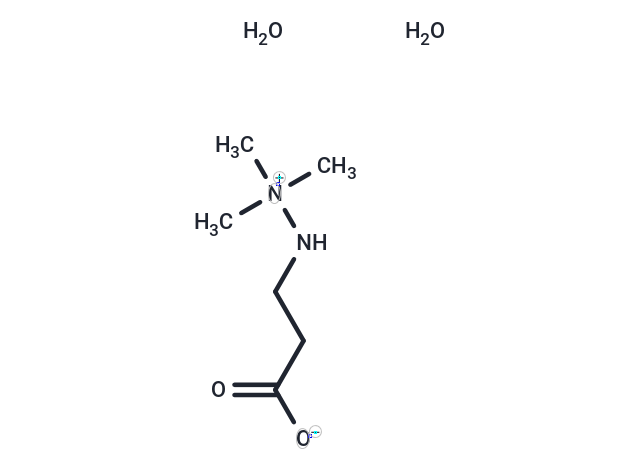Shopping Cart
- Remove All
 Your shopping cart is currently empty
Your shopping cart is currently empty

Mildronate dihydrate is an inhibitor of biosynthesis of L-carnitine by gamma-butyrobetaine (GBB) hydroxylase and as a competitive inhibitor of renal carnitine reabsorption.

| Pack Size | Price | Availability | Quantity |
|---|---|---|---|
| 25 mg | $38 | In Stock | |
| 50 mg | $56 | In Stock | |
| 100 mg | $81 | In Stock | |
| 500 mg | $197 | In Stock | |
| 1 mL x 10 mM (in H2O) | $29 | In Stock |
| Description | Mildronate dihydrate is an inhibitor of biosynthesis of L-carnitine by gamma-butyrobetaine (GBB) hydroxylase and as a competitive inhibitor of renal carnitine reabsorption. |
| Targets&IC50 | BBOX (human recombinant):34-62 μM (IC50), OCTN2 (human):21 μM (EC50) |
| In vitro | Mildronate (40 μM) inhibits the reaction of γ-butyrobetaine hydroxylase with γ-butyrobetaine with Km and Vmax of 36.8 μM and 0.08 nmol/min/mg protein, respectively. [1] |
| In vivo | Mildronate administered orally to rats for 10 days (150 mg/kg) elicits a reduction in myocardial free camitine and long-chain acyl carnitine content by 63.7 and 74.3%, respectively. Mildronate treatment (100 mg/kg, orally) subsequent administration of isoproterenol results in a reduction in free camitine concentration by 48.7% in comparison with the rats receiving isoproterenol. A prior administration of Mildronate effectively protects the myocardium from isoproterenol-induced variations in the content of ATP and myocardial energy charge, as well as preventing a rise in creatine phosphokinase and lactic dehydrogenase activity. [1] Mildronate (200 mg/kg) long-term treatment significantly increases the rate of insulin-stimulated glucose uptake by 35% and the expression of glucose transporter 4 (1.7-fold increase), hexokinase II (2.1-fold increase), insulin receptor proteins (2.5-fold increase) and carnitine palmitoyltransferases IA (2.2-fold increase) in mouse hearts. Mildronate long-term treatment statistically significantly decreases fed state blood glucose from 6 to 5 mM. [2] Mildronate reduces the azidothymidine-induced alterations in mouse brain tissue. Mildronate (50 mg/kg) normalizes the increase in caspase-3, cellular apoptosis susceptibility protein (CAS) and iNOS expression. Mildronate also normalizes the changes in cytochromec oxidase (COX) expression, reduces the expression of glial fibrillary acidic protein (GFAP) and cellular infiltration. [3] |
| Alias | Mildronate, Meldonium |
| Molecular Weight | 182.22 |
| Formula | C6H18N2O4 |
| Cas No. | 86426-17-7 |
| Smiles | O.O.C[N+](C)(C)NCCC([O-])=O |
| Relative Density. | no data available |
| Storage | Powder: -20°C for 3 years | In solvent: -80°C for 1 year | Shipping with blue ice. | ||||||||||||||||||||
| Solubility Information | DMSO: Insoluble H2O: 10 mM, Sonication is recommended. | ||||||||||||||||||||
Solution Preparation Table | |||||||||||||||||||||
H2O
| |||||||||||||||||||||

Copyright © 2015-2025 TargetMol Chemicals Inc. All Rights Reserved.